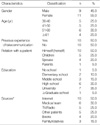Abstract
Purpose
This study was conducted to develop the telecommunication guideline that was possible to make the immediate, logical decisions and to evaluate the possibility of the use by verifying it from the specialists' group.
Methods
Telecommunication guideline was designed with selected six symptoms which were pain, dyspnea, nausea/vomiting, diarrhea, fever, and cough based on the results of literature.
Results
This study showed that the patients understood well about the contents of the questions, examination, and education. Also, 85% of them fulfilled the guidelines of the adjustment and more of them were satisfied with the results shown to all of them compared to the previous telecommunication. And 95% of them replied that the information from the telecommunication was more useful than any other information sources related to the information of cancer and self management that were used previously.
Conclusion
The telecommunication was considered to complement the weakness during the time the cancer patients spent at home after the treatments. Also, it was expected to be a role as an immediate and comprehensive method of decision making and a passage for information supply which was considered the specialty of individual patient related to an inquiry of the self management.
Figures and Tables
References
1. Oh EG. Functional status lung cancer. J Korean Acad Adult Nurs. 2002. 14:491–500.
2. Chung BY, Kim KH. Nursing needs and family burdens of caregivers who have had terminal cancer patinets. J Kyungpook Nurs Sci. 2003. 7:63–82.
3. Lee SW, Lee EO, Huh DS, Noh KH, Kim HS, Kim SR, et al. The study on the medical and nursing service neeeds of the terminal cancer patients and their caregivers. J Korean Acad Nurs. 1998. 28:958–969.

4. Sheen SS. Development of clinical parctice guidelines. J Korean Soc Qual Assur Health Care. 2003. 10:266–277.
5. Margaret H, Susan N. Telephone triage for oncology nurses. 2005. Pittburgh, PA: Oncology Nursing Society.
6. Telephone nursing practice and symptom management guidelines. Nursing Professional Advisory Committee. accessed on 3 March 2009. Available at: http://www.cancercare.on.ca/common/pages/UserFile.aspx?fileId=13838.
7. Korean Society for Hospice and Palliative Care (KSHPC) & Korean Cancer Study Group (KCSG). Cancer pain guideline. 2001. Seoul: Koonja.
8. Chang HK. Development of web-based self-care algorithms on symptom management for cancer patients [dissertation]. 2000. Seoul: Seoul National Univ..
9. Lee EO, Kim JE, Park HA, Kwon IG. Development and evaluation of symptom management guidelines for cancer patients. J Korean Acad Adult Nurs. 2005. 17:208–218.
10. Greenberg ME, Schultz C. Telephone nursing: client experiences and perceptions. Nurs Econ. 2002. 20:181–187.
11. Kim AS, Lee ES, Kim SH. Effects of telephone intervention as supportive nursing on self-care practices and quality of life for gynecological cancer patients under chemotherapy. J Korean Acad Nurs. 2007. 37:744–753.

12. Kim KH, Park KS. Theory and Practice of telephone counseling. 1993. Seoul: Samwon.
13. Song AS, Park IH, Joo AR. Effects of supportive care using the telephone for mothers of premature infants an anxiety and confidence of baby care after discharge. J Korean Soc Matern Child Health. 2007. 11:98–108.
14. Song MS, Kim HS. Effects of diabetes education and telephone counseling on depression in patients with diabetes. J Korean Acad Adult Nurs. 2008. 20:481–488.
15. Lee SH. The Effect of a telephone follow-up management self-efficacy and Self-care activities in Continuous Ambulatory peritoneal Dialysis (CAPD) patients [dissertation]. 2006. Incheon: Gachon Univ. of Medicine and Science.
16. Kwon KE. Information needs & satisfaction among family members of terminal cancer patients using phone counselling [dissertation]. 2008. Seoul: Hanyang Univ..
17. Kim HJ. Analysis of users' satisfaction for telephone cancer information service [dissertation]. 2006. Seoul: Yonsei Univ..




 PDF
PDF ePub
ePub Citation
Citation Print
Print









 XML Download
XML Download